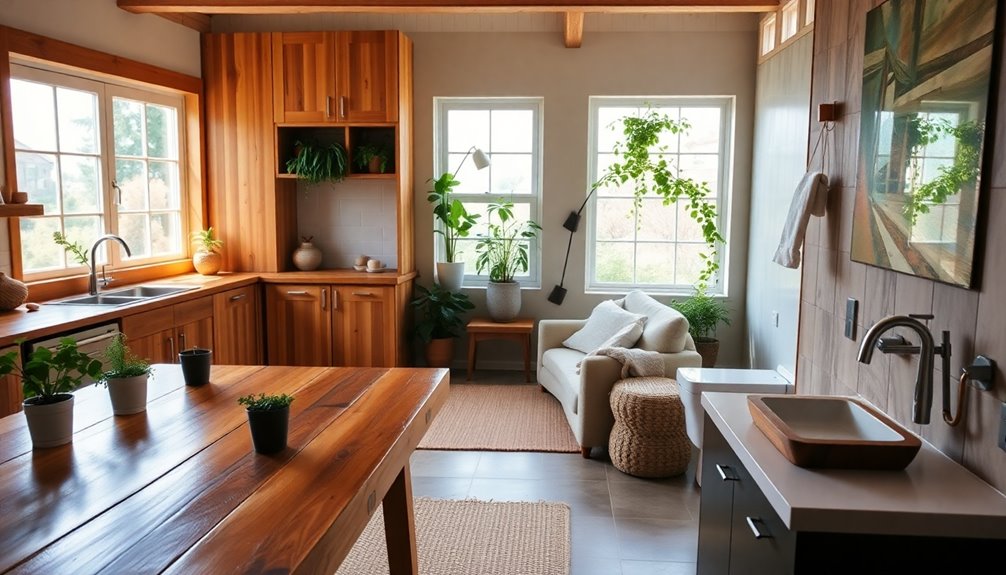You can easily make sustainable choices for every room in your home. Start by swapping out traditional bulbs for energy-efficient LEDs to save on electricity. In the kitchen, opt for appliances with ENERGY STAR ratings and use reusable bags. Upgrade your bathroom with low-flow showerheads and toilets to cut water usage. For your bedroom, choose organic bedding and eco-friendly mattresses. Incorporate indoor plants for cleaner air, and select sustainable materials for furniture. Remember, every small change adds up, and there's plenty more you can do to enhance your home's sustainability. Discover how to make more impactful choices throughout your space.
Key Takeaways
- Install energy-efficient lighting, such as LED bulbs and smart systems, to reduce electricity costs across all rooms.
- Choose sustainable flooring materials like bamboo or reclaimed wood to minimize your environmental impact.
- Implement water-saving fixtures, such as low-flow showerheads and toilets, to conserve water in bathrooms.
- Incorporate indoor plants to improve air quality and enhance relaxation throughout your living spaces.
- Select eco-friendly furniture made from sustainable materials and verify responsible sourcing to support a greener home.
Energy-Efficient Lighting Solutions

Switching to energy-efficient lighting solutions can make a significant difference in your home's energy consumption and utility bills. By replacing traditional incandescent bulbs with LED lights, you can save up to 75% on electricity costs. This shift not only enhances energy efficiency but also contributes to a greener environment. Additionally, installing an air purifier can further improve indoor air quality, promoting a healthier living space. Regular maintenance of your air purifier, including cleaning filters, ensures that it operates at peak efficiency.
Choosing ENERGY STAR-rated lighting fixtures can help you save energy even further, potentially lowering your utility bills by about $225 annually when you use LED technology.
Maximizing natural light through strategic window placement and light-colored walls can also reduce your reliance on artificial lighting during the day. This simple change allows you to enjoy a brighter, more inviting space while conserving energy.
Additionally, incorporating smart lighting systems enables you to automate control and scheduling, optimizing energy use and reducing waste when rooms are unoccupied.
Using dimmers and motion sensors can further enhance energy efficiency, adjusting light levels based on your needs. Furthermore, implementing energy-efficient technology in other areas of your home can lead to even greater savings and sustainability benefits. By implementing these energy-efficient lighting solutions, you'll not only create a more sustainable home but also enjoy significant savings on your monthly bills.
Embrace these changes, and watch your energy consumption decrease while your comfort increases.
Sustainable Flooring Options
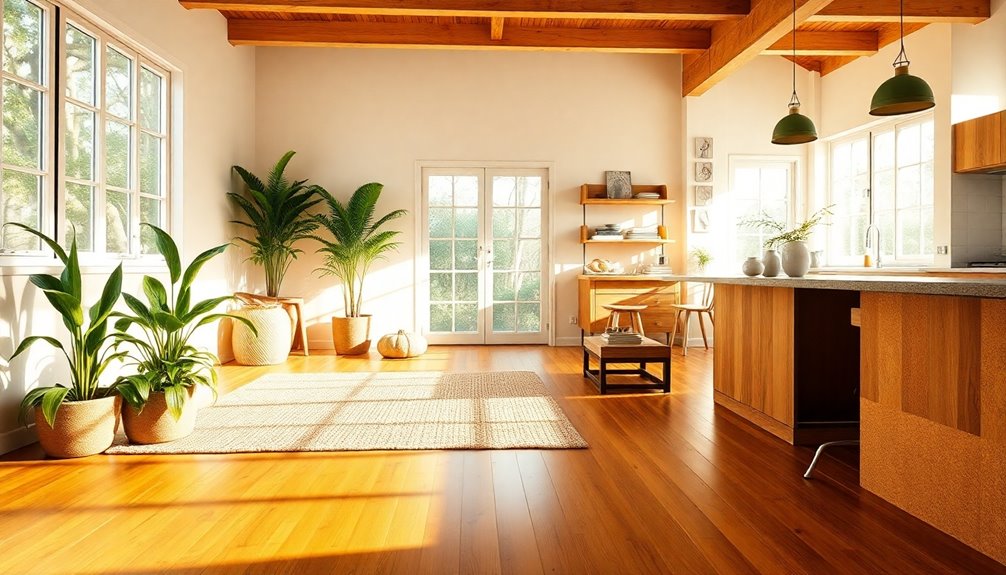
When choosing sustainable flooring, you'll want to contemplate eco-friendly materials that not only look great but also have a minimal environmental impact.
Options like bamboo and reclaimed wood offer durability while reducing waste, ensuring your space remains stylish and sustainable.
Plus, think about maintenance—selecting materials that are easy to care for can enhance your home's longevity and sustainability.
Eco-Friendly Materials Selection
Choosing sustainable flooring options for your home not only enhances its aesthetic appeal but also contributes to a healthier environment. By selecting eco-friendly materials, you can create a space that reflects your commitment to sustainability.
Bamboo is an excellent choice; it grows fully in just three years, making it a rapidly renewable resource compared to traditional hardwoods.
Cork flooring is another sustainable option, as it harvests only the bark of the cork oak tree, allowing the tree to thrive and continue sequestering carbon. If you're looking to minimize environmental impact, consider reclaimed wood flooring, which repurposes existing materials and reduces the need for new lumber.
For a cozy touch, natural fiber carpets made from biodegradable materials like wool or jute often use fewer chemicals, improving indoor air quality.
Finally, don't overlook concrete flooring; it's durable and offers great insulation properties, helping to regulate indoor temperatures and reduce energy consumption.
Durability and Maintenance Considerations
Durability and maintenance are essential factors to take into account when selecting sustainable flooring options for your home. You want flooring that not only looks good but also withstands the test of time.
Eco-friendly flooring like bamboo can last up to 50 years with the right care, making it a robust choice for sustainable living spaces.
Cork flooring is another excellent option, as it's naturally resistant to mold, mildew, and pests, leading to lower maintenance needs and a healthier indoor environment.
If you're considering concrete flooring, know that its durability comes with added benefits, like excellent insulation properties that can reduce your energy costs over time.
For those who appreciate aesthetics, reclaimed wood offers lasting beauty while minimizing environmental impact through reuse.
Natural fiber carpets, although soft and appealing, can also be easy to maintain with low-impact cleaning methods, contributing to better indoor air quality.
Eco-Friendly Kitchen Practices
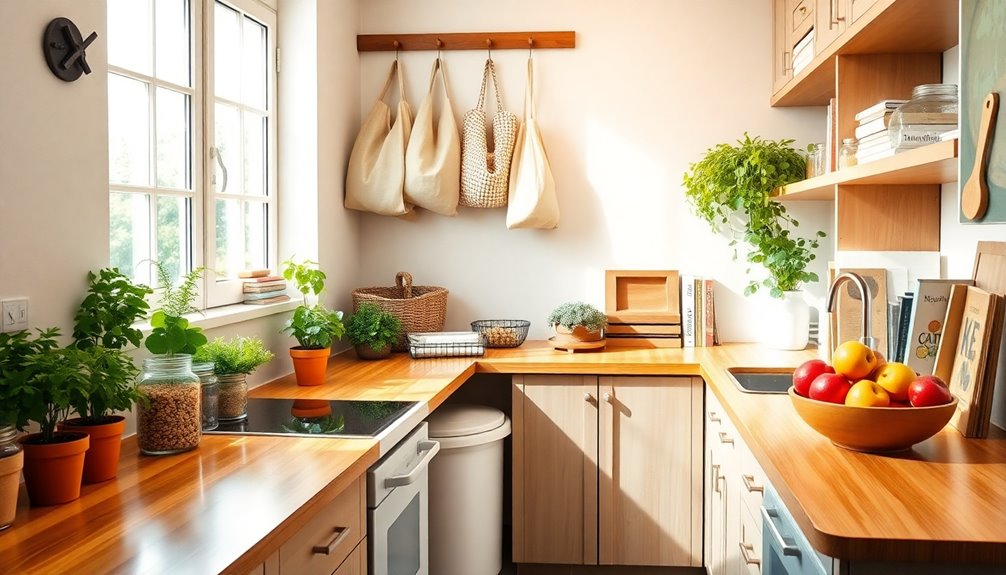
Transform your kitchen into an eco-friendly haven by adopting sustainable practices that not only benefit the environment but also enhance your daily life.
Start by reducing food waste through meal planning and incorporating a compost bin for scraps. Remember, about 35% of the U.S. food supply is wasted, which drives greenhouse gas emissions. Additionally, using natural air purification methods can help reduce odors from food waste in your kitchen.
Opt for reusable containers and bags to minimize single-use plastics and unnecessary packaging. Proper food storage techniques, like separating ethylene-producing foods, can extend freshness and reduce spoilage. This simple step helps you save money and food.
Invest in Energy Star-rated appliances to cut down energy consumption and lower utility bills. You'll appreciate the efficiency they bring to your kitchen. Moreover, using energy-efficient appliances can significantly reduce your overall environmental impact.
Additionally, choose natural, biodegradable cleaning products to create a healthier environment. These products are less harmful to both your health and the planet.
Finally, consider integrating eco-friendly laundry practices by washing clothes in cold water, which saves energy while maintaining fabric quality.
Water-Saving Bathroom Tips

You can make a significant impact on water conservation in your bathroom with a few simple adjustments.
Start by installing low-flow showerheads, which can save you about 2.5 gallons of water per minute. That adds up quickly! Additionally, consider the energy savings associated with reduced hot water usage, which further enhances your home's sustainability. Using energy-efficient systems like heat pumps can also minimize the overall demand for hot water, contributing to water conservation efforts. Choosing products made from eco-friendly materials can also support a sustainable bathroom environment.
Reflect on replacing your standard toilet with a low-flow model that uses only 1.6 gallons per flush, compared to the 3.5 gallons of traditional toilets. This switch can lead to substantial water savings over time.
Be proactive about fixing any leaks in your faucets and toilets, as these can waste up to 90 gallons of water daily.
Also, try shortening your showers by just one minute; you'll save around four gallons of water each time, which contributes to considerable savings annually.
Lastly, use aerators on your faucets. They help maintain water pressure while reducing flow, allowing you to use less water without sacrificing performance.
By implementing these water-saving tips, you not only help the environment but also save energy and reduce your utility bills, making your home more sustainable. Additionally, consider the importance of regular maintenance to ensure your heat pump operates efficiently, further enhancing your home's sustainability.
Every small change counts!
Health-Conscious Bedding Choices

Creating a healthier sleep environment starts with your bedding choices. By opting for health-conscious bedding, you can greatly reduce your exposure to harmful chemicals and enhance your overall well-being. Here are a few tips to think about:
- Choose bedding made from organic materials, like sustainably-sourced cotton or bamboo, to minimize pesticide exposure.
- Invest in eco-friendly mattresses made from natural latex or plant-based memory foam for a non-toxic and comfortable sleep. Herbal teas, such as chamomile, can also promote relaxation and improve your sleep quality. Additionally, consider incorporating essential oils for aromatherapy to create a calming atmosphere that enhances your nighttime routine.
- Select bedding treated with non-toxic, water-based dyes to improve indoor air quality.
Additionally, reflect on using natural fiber bedding, such as linen or wool. These materials enhance breathability and moisture-wicking properties, ensuring a more comfortable sleep.
Regularly washing your bedding in cold water not only saves energy but also helps reduce allergens, contributing to healthier sleep environments. Incorporating essential oils for relaxation can further enhance your sleep quality and create a soothing atmosphere.
Finally, don't forget to utilize natural cleaning products for your bedding maintenance, further promoting non-toxic living.
Indoor Plant Benefits
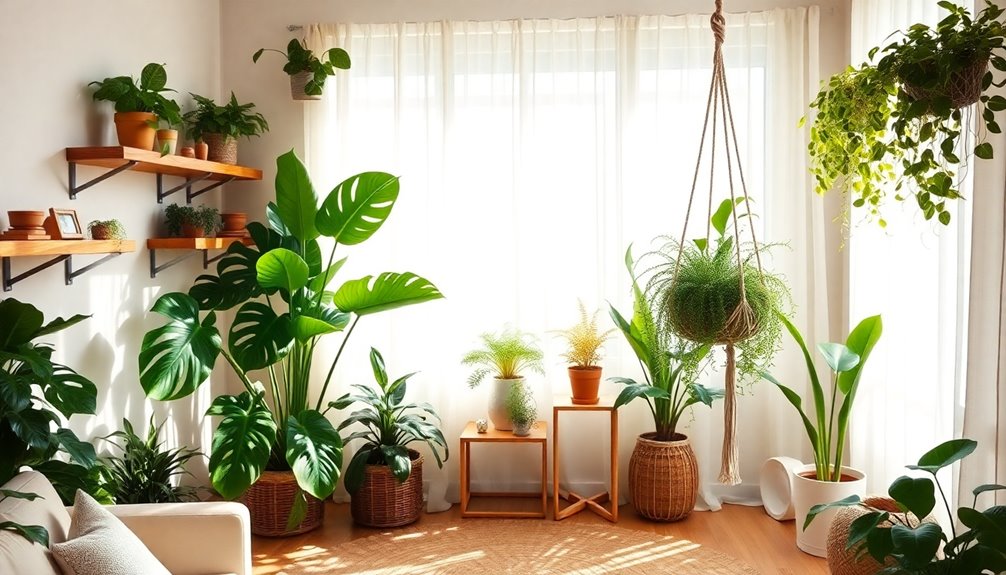
Enhancing your home's sustainability doesn't stop at bedding; incorporating indoor plants is another fantastic way to promote a healthier living environment. Indoor plants play a vital role in improving air quality by filtering out toxins like formaldehyde and benzene, making your space healthier for you and your family.
Plants such as spider plants and peace lilies not only purify the air but also increase indoor oxygen levels, which can greatly boost your mental health. Research suggests that emotional regulation can be positively influenced by the presence of plants, contributing further to a calming home environment.
Studies have shown that having greenery around can reduce stress levels and foster feelings of calm and relaxation. This contributes to better overall mental health, helping you feel more at ease in your home.
Additionally, incorporating plants can enhance productivity; some research indicates a remarkable 15% increase in cognitive function in plant-filled environments. Furthermore, utilizing self-watering planters can significantly simplify the maintenance of indoor greenery, ensuring your plants thrive with minimal effort.
Indoor plants also help regulate humidity levels, which can alleviate respiratory issues and dry skin, improving your comfort indoors.
By making these sustainable choices, you're not just beautifying your home; you're also positively impacting your health and well-being, while reducing your environmental impact.
Responsible Furniture Selection
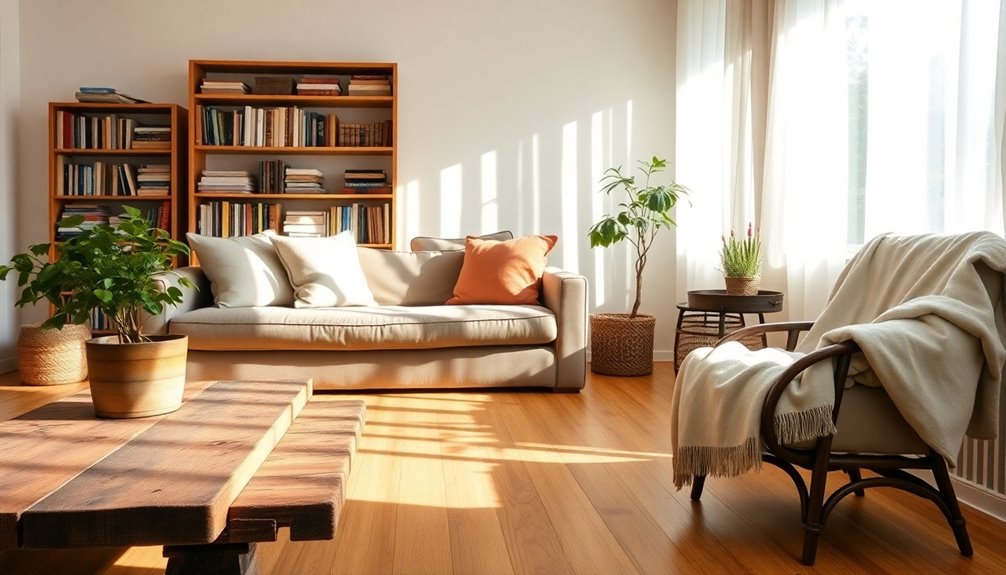
When it comes to furnishing your home, making responsible choices can greatly impact both your health and the environment. By selecting furniture wisely, you can create a space that’s not only stylish but also sustainable. Luckily, there are many options for sustainable furniture, from reclaimed wood to eco-friendly materials. Additionally, incorporating genius home decor hacks, such as using vintage or thrifted items, can add a unique flair to your space while also reducing waste. By making conscious choices and getting creative with your home decor, you can create a beautiful and eco-friendly home. You can further enhance your sustainable home by opting for decorative pillows for sofas made from organic fabrics or recycled materials. These small touches not only add comfort and style but also support eco-conscious manufacturing practices. Moreover, by mixing and matching different textures and colors, you can personalize your space while remaining committed to sustainability.
Here are some key points to take into account:
- Choose sustainable materials: Look for options made from reclaimed wood or bamboo, which grows quickly and reduces the need for new resources.
- Opt for second-hand furniture: This choice helps minimize waste and supports the circular economy by extending the life of existing products.
- Select natural fibers: Furniture made from organic cotton or linen can reduce your exposure to harmful chemicals and improve indoor air quality.
Additionally, always check for the FSC label to verify responsible sourcing and a lower carbon footprint.
Incorporating eco-friendly finishes and non-toxic materials in your furniture design will further contribute to a healthier living environment.
Waste Reduction Strategies

Cutting down on waste in your home isn't just a trend—it's a necessity for a sustainable future. By implementing smart waste reduction strategies, you can markedly lower your environmental impact. Start with composting to divert organic waste from landfills, as food waste accounts for 6% of global greenhouse gas emissions. Using non-combustible materials for wood stove installation can also help minimize waste and ensure safety in your home. Additionally, incorporating heat pump technology can efficiently manage energy consumption while reducing overall waste generation. In fact, energy-efficient models can significantly lower your heating and cooling costs, contributing to your sustainability goals. Use reusable containers and bags to minimize single-use plastics, especially considering the 12 million tons of furniture waste generated in 2018 alone.
Repairing and repurposing items can help reduce the 17 million tons of textiles discarded in U.S. landfills. Opt for bulk buying to cut down on packaging waste and enhance sustainability. Finally, establish a recycling system for materials like paper, glass, and metal to effectively reduce overall waste in your home. Additionally, reducing reliance on traditional wood-burning methods can contribute to a cleaner environment.
| Strategy | Benefits | Materials Affected |
|---|---|---|
| Composting | Reduces organic waste | Food scraps |
| Reusable Bags | Minimizes single-use plastics | Plastic bags |
| Repair/Repurpose | Extends the life of items | Furniture, textiles |
| Recycling | Diverts materials from landfills | Paper, glass, metal |
Smart Home Technologies
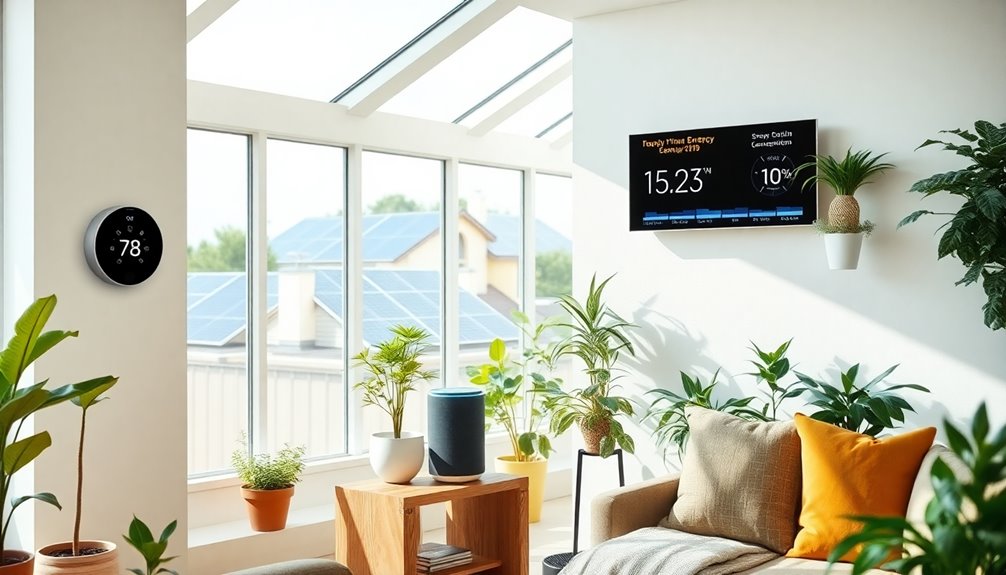
In today's eco-conscious world, smart home technologies offer an innovative way to boost your home's sustainability while reducing energy costs. By integrating these devices, you can greatly enhance your energy efficiency and comfort.
Here are some smart technologies to evaluate:
- Smart Thermostats: These devices can save you up to 10% on heating bills by optimizing energy use throughout the day.
- Energy Monitors: Keep track of your household energy consumption, helping you identify areas where you can cut back.
- Automated Shading Systems: Adjust according to sunlight exposure, effectively lowering energy usage and improving indoor climate control. Additionally, smart utilities for home can further enhance your resource management. Moreover, implementing AI-driven encryption methods in your smart home devices can protect sensitive data from cyber threats.
Furthermore, incorporating ENERGY STAR-rated appliances can lead to savings of up to 30% on energy bills compared to standard models. Additionally, pairing these appliances with renewable energy sources can maximize your energy savings and sustainability efforts.
Furthermore, when combined with heat pump technology, these smart systems can significantly enhance your home's overall energy efficiency and comfort levels.
By automating your lighting, heating, and cooling systems, you can maintain a comfortable environment while minimizing waste.
These technologies not only help you save money but also contribute to a more sustainable lifestyle. Embracing smart home solutions is a proactive step towards reducing your carbon footprint and creating a greener future.
Frequently Asked Questions
What Are Ways to Be Sustainable at Home?
To be sustainable at home, you can start by switching to energy-efficient LED bulbs, which cut your electricity bills considerably.
Install low-flow faucets and showerheads to save water without sacrificing performance.
Consider investing in a programmable thermostat to optimize heating and cooling costs.
Use eco-friendly materials for furniture and flooring, and set up a composting system for organic waste.
These actions not only reduce your environmental impact but also save you money in the long run.
What Are Good Examples of Sustainability Ideas?
What if you could transform your living space into an eco-friendly haven? You can start by swapping out traditional bulbs for energy-saving LEDs, slashing your electricity costs.
Try installing low-flow faucets and showerheads to cut water usage in half.
Don't forget to choose furniture made from reclaimed wood, adding character while supporting sustainability.
And in the kitchen, set up a composting system to reduce waste.
These simple steps can make a big impact!
What Is the Most Sustainable Thing to Build a House Out Of?
When you're considering the most sustainable materials for building a house, bamboo is a fantastic option due to its rapid growth and quick harvest time.
Reclaimed wood not only gives your home character but also minimizes waste.
Cork, harvested from trees without harm, offers insulation benefits.
Straw bales serve as a renewable insulation source, while hempcrete provides excellent insulation and absorbs carbon dioxide.
Each choice contributes to a more eco-friendly and efficient home.
What 7 Elements Are Required for Sustainable Building Design?
Building sustainably is like planting seeds for a better future. To achieve this, you'll need seven essential elements: energy efficiency, water conservation, sustainable materials, indoor environmental quality, waste reduction, site selection, and community engagement.
Each element interlocks, creating a strong foundation. You'll find that energy-efficient systems cut costs, while eco-friendly materials enhance durability.
Prioritizing these elements not only benefits you but also nurtures the planet we all share.
